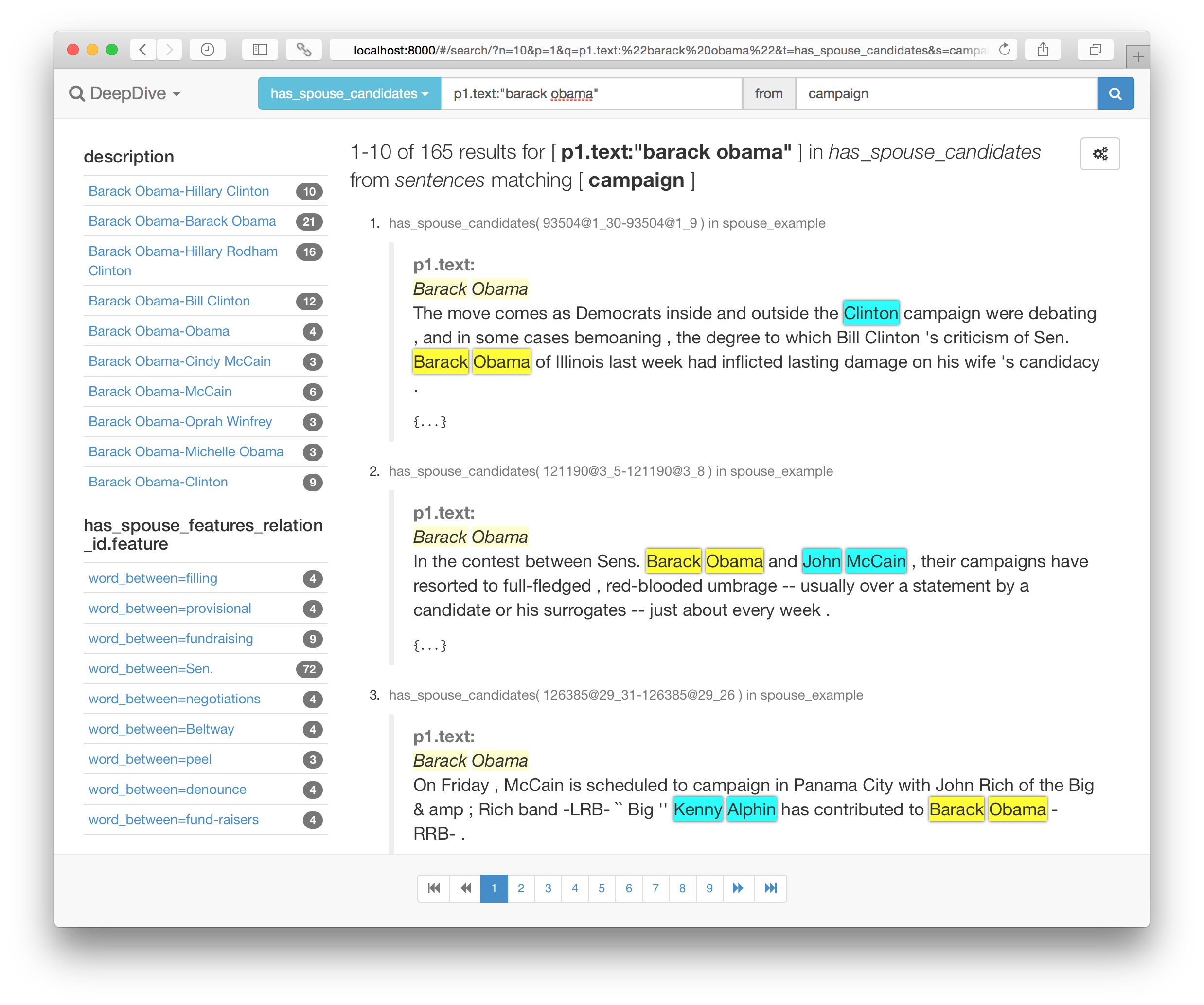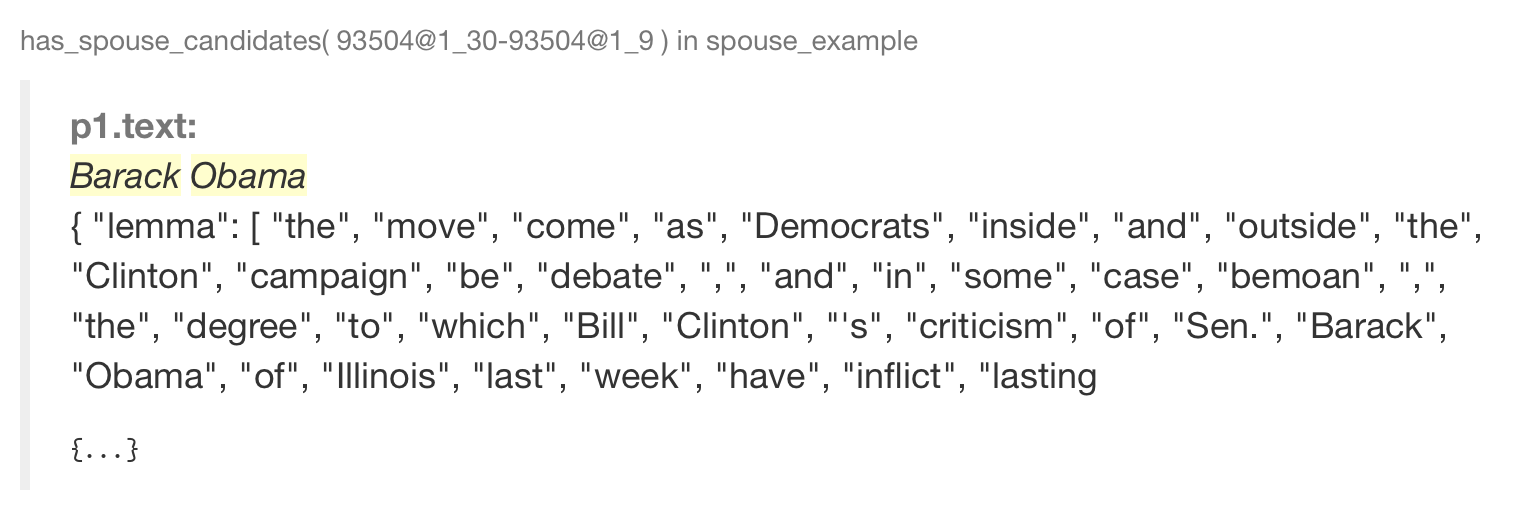Browsing DeepDive data with Mindbender
This document describes how one can easily bring up an interactive search interface to browse data produced by DeepDive as well as its input/source data. Your DeepDive application must be written in DDlog to be able to use this functionality.
Currently, the functionality only works with PostgreSQL versions 9.3 or later because it relies on the to_json() support.
We plan to lift this limitation soon and support Greenplum/PostgreSQL-XL as well as to grow the underlying Elasticsearch cluster for applications with large data.
QuicksStart
1. Annotate DDlog relations
First of all, you must add some annotations to the DDlog schema declarations of the relations to be browsed.
Annotations are extra information placed before the relation name or column name in DDlog schema declarations that are written like @extraction or @references(relation="foo", column="bar").
There's an example of a DDlog program annotated for browsing.
Associations between relations are annotated with
@keyand@referencescolumns. For example, the following annotates thatentity'sdoc_idrefers to adocument.document( @key id text, ... ). entity( ..., @references(relation="documents", column="id") doc_id text ).Relations to be made browsable are annotated with either
@extractionor@source.- All other relations associated with
@referencesand@keyare nested under the browsable relation. - An
@extractionrelation should have@referencescolumns to a@sourcerelation.
- All other relations associated with
All columns of the browsable relations are full-text searchable.
@searchablecolumns are used for presenting the search results with highlights.@navigablecolumns and@searchablecolumns are used for faceted navigation.
2. Populate the search index
Next, the relations to be browsed must be added to the search index, powered by Elasticsearch.
mindbender search update
3. Start the GUI
Finally, a GUI can be started with the following command:
mindbender search gui
Point your browser to http://localhost:8000/#/search to start searching and browsing the indexed relations.

Elasticsearch manual on query string syntax tells you how to formulate sophisticated query strings that can limit fields, do wildcards, fuzzy search, regular expressions, filtering, and grouping with boolean operators.
Typical schema in DDlog/DeepDive
DeepDive applications written in DDlog typically use multiple relations falling into one of the following categories:
- Relation that holds source (input) data
- text corpus with NLP markups
- dictionaries, controlled vocabularies
- ontologies, knowledge bases, known relationships
- Relation that holds extractions
- candidates
- mentions, relationship mentions, entity links
- features
- supervision labels
- Relation that holds predictions (random variables)
- whose expectation predicted by DeepDive
For example, in the spouse example we use in DeepDive's tutorial, the relations are:
- Source
articlessentencesspouse_dbpedia
- Extraction
person_mentionspouse_candidatespouse_featurespouse_label
- Prediction
has_spouse
DDlog annotations for browsing
DDlog allows relations and columns in the schema to be annotated with any number of annotations with @name(arguments) syntax.
Arguments are optional, e.g., @tag is also a valid annotation.
Arguments can be either an unnamed list of values, e.g., @foo(1,"two", 3.45), or a map of named values, e.g., @bar(number=1,string="two",double=3.45).
Permitted argument values are integers, floating point numbers, or strings.
Annotations for association between DDlog relations
@key columns
Every relation can have one or more columns annotated with @key.
A relation's primary key should be the only column annotated with this.
When more than one column is annotated, it means all of them combined form a key for the tuples in the relation.
@references(relation, [column], [alias]) columns
Columns whose value references another relation's key can be annotated with @references with the target relation name as a relation argument.
When more than one column forms a key for the target relation, the target column name to which the annotated column refers should also be passed as an extra column argument.
When a relation references the same relation more than one time that is typical for homogeneous relationships, e.g., has_spouse referring to person_mention twice, an extra alias argument can be provided for clarity.
If the target relation has multiple @key columns, the alias argument must be specified to distinguish exactly which @key column in the target relation the annotated column refers to.
In such case, the @references columns with the same alias argument as a whole tells to which tuple in the target relation it's referring.
Annotation for extractions and search
One of the main consumers of DDlog annotations is the search interface. It enables full-text search over the data products of DeepDive applications as well as their input data. Elasticsearch is used in the backend, and the DDlog annotations dictate how the data produced by DeepDive stored in a relational database should be unloaded and transformed into Elasticsearch's document model to answer typical keyword and aggregate queries.
@extraction([label]) relations
A relation that holds extracted data can be annotated as @extraction with an optional label.
In the search interface, @extraction relation becomes a searchable "type" and every tuple of it becomes the unit of search results.
If an extraction is represented by many DDlog relations all associated through @references, only the primary relation needs such annotation, e.g., only person_mention and has_spouse need @extraction because spouse_feature holds extra/auxiliary information related to has_spouse.
@searchable([relation, ...]) columns
Any column annotated with @searchable that's directly or indirectly associated with an @extraction relation (or a relation that corresponds to a searchable type) is indexed for searching and appears in the result highlighted.
Optionally, names of the @extraction relations can be specified as arguments to limit the search indexes the column participates in.
@source([label]) relations
A relation that holds the input/source data to DeepDive should be annotated as @source with optional label.
The @source relations themselves become a searchable type in the search interface as well.
Every @extraction relation is supposed to record its provenance in column(s) that @references one of the @source relations.
There are two reasons why @source relations are explicitly annotated.
First, since the typically larger @source relations may change less frequently than the @extractions derived from them as the DeepDive application evolves, we can avoid reindexing a large part of the data that stays mostly invariant.
Specifically, Elasticsearch's parent-child mapping is used to decouple the frequently changing @extractions from their @sources.
Second, given how the searchable data to be indexed is determined from the annotations, @source relations provide natural breaking points while following the association links between relations.
In other words, because independent @extractions can reference a @source relation as its provenance, to make each @extraction searchable, we may end up collecting data for all other @extractions from the same @source.
Annotation for aggregation / faceted search
@navigable([relation, ...]) columns
Similar to @searchable, any column annotated with @navigable that's directly or indirectly associated with a relation that corresponds to a searchable type is indexed for faceted navigation.
Upon every search, handful of significant terms or value ranges found for the column will appear with their approximate counts to help narrowing down the search result.
For example, if label column is annotated as @navigable, every search result will show how many were distantly supervised as positive and negative examples among the result and quickly drill down to them.
Annotation for presentation
In addition to the @searchable columns, typical @extractions record extra provenance details with respect to the @source, and special presentation of the data is often necessary for human consumption.
For example, person_mention are text spans in sentences each of which is represented by an array of indexes to the tokens of the source sentence.
A sensible presentation of such array of indexes is highlighting the corresponding words in the original sentence text with different colors rather than just showing the raw numbers.
Similarly, tables, figures, images, and other data types all have a similar issue: extra columns of @extractions typically hold extra detail that can be visualized in data-dependent ways.
Customizing presentation
Presentation templates
How a browsable relation is presented in the GUI can be fully customized by creating an HTML-like template under the DeepDive application.
For example, relation has_spouse is rendered using a template at ./mindbender/search-template/has_spouse.html when it exists.
It is in fact an AngularJS template where the object to be rendered is accessible with scope variable extraction or source, depending on whether the browsable relation is an extraction or source.
For extractions, source variable may also point to its provenance source object.
Here's an example for rendering has_spouse in the spouse example as highlighted text spans with two colors.
The mindtagger-word-array and mindtagger-highlight-words are AngularJS directives provided by Mindtagger, a tool for labeling data.
<a mb-search-link="{{extraction.p1.mention_text}}"><strong>{{extraction.p1.mention_text}}</strong></a>
--
<a mb-search-link="{{extraction.p2.mention_text}}"><strong>{{extraction.p2.mention_text}}</strong></a>
<br> E=<strong>{{extraction.expectation}}</strong>
<br><small class="text-muted">See all
<a mb-search-link='feature:* "{{extraction.p1_id}}@{{extraction.p2_id}}"'>features</a>
/
<a mb-search-link='label:* "{{extraction.p1_id}}@{{extraction.p2_id}}"'>labels</a>
</small>
<small class="text-muted">
in <a mb-search-only="sentences" mb-search-link="{{extraction.p1.doc_id}} sentence_index:{{extraction.p1.sentence_index}}">sentence {{extraction.p1.sentence_index}}</a>
in <a mb-search-only="articles" mb-search-link="{{extraction.p1.doc_id}}">article({{extraction.p1.doc_id}})</a>:
</small>
<div mindtagger-word-array="source.tokens">
<mindtagger-highlight-words from="extraction.p1.begin_index" to="extraction.p1.end_index" with-style="background-color: yellow;"/>
<mindtagger-highlight-words from="extraction.p2.begin_index" to="extraction.p2.end_index" with-style="background-color: cyan;"/>
</div>
Without the template, the GUI would render by default a has_spouse in a hard-to-read format:

This is improved as shown below by creating the template above in the application:

AngularJS extensions
To define further AngularJS extensions, such as directives or filters to be used in the templates, define a mindbender.extensions module in ./mindbender/extensions.coffee or ./mindbender/extensions.js.
This can be very useful if you need to share some template fragments or scripts across many browsable relations.
###
To define your AngularJS extensions for the custom templates in Mindbender,
your own JavaScript/CoffeeScript code can be put at mindbender/extensions.js
or mindbender/extensions.coffee file under the working directory where you
start `mindbender gui`. All files under the mindbender/ directory will be
available under the same relative path, e.g., an AngularJS template stored
in mindbender/foo.html will be available as "mindbender/foo.html". Hence,
you can use arbitrary number of files to define your extensions.
###
angular.module "mindbender.extensions", [
"mindbender.search"
]
.directive "mbSearchLink", ($location, DeepDiveSearch) ->
link: ($scope, $element, $attrs) ->
$scope.$watch (-> $attrs.mbSearchLink), ->
params = _.extend {}, DeepDiveSearch.params
params.s = $attrs.mbSearchLink
params.t = $attrs.mbSearchOnly
params.p = 1
$element.attr "href", "#/search/#{
unless DeepDiveSearch.index? then ""
else encodeURIComponent DeepDiveSearch.index}?#{(
"#{encodeURIComponent k}=#{encodeURIComponent v ? ""}" for k,v of params
).join("&")}"
.directive "mbView", (DeepDiveSearch) ->
scope:
mbView: "="
mbViewType: "@"
link: ($scope, $element, $attrs) ->
# TODO use hit and https://github.com/HazyResearch/mindbender/blob/master/gui/frontend/src/search/search.html#L92-L96
$element.attr "href", "#/view/#{encodeURIComponent DeepDiveSearch.index}/#{
encodeURIComponent $scope.mbViewType}/?id=#{
encodeURIComponent $scope.mbView}#{
unless DeepDiveSearch.routing? then ""
else "&routing=#{DeepDiveSearch.routing}"
}"
.filter "uri", () ->
(s) -> encodeURIComponent s

